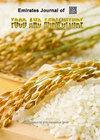南瓜(Cucurbita maxima)、玉米(Zea mays)、大豆(Glycine max)复合粉替代小麦粉的营养饼干研制及品质评价
IF 0.7
4区 农林科学
Q3 AGRONOMY
引用次数: 0
摘要
营养物质对人体的生长发育至关重要。营养摄入不足严重影响幼儿的生长和智力发育。本研究的目的是用南瓜(Cucurbita maxima)、大豆(Glycine max)和玉米(Zea mays)的复合面粉为5岁以下的儿童配制和开发一种营养丰富的婴儿饼干。将小麦粉与南瓜粉、大豆粉、玉米粉分别按100:0:0:0 (T1)、85:5:5:5 (T2)、70:10:10:10 (T3)、55:15:15:15 (T4)的比例混合制备复合面粉。通过功能特性、微生物品质相关参数、感官特性和近似成分分析评价复合面粉的适宜性。复合面粉的吸水能力、吸油能力和泡沫能力显著高于小麦粉(p <0.05)。采用处理3 (T3: 70:10:10:10),复合面粉添加量为30%,优选出最佳的婴儿饼干。婴儿饼干的颜色、风味、质地和总体可接受性显著提高(p <0.05)。复合面粉(T3)水分3.96%,灰分2.66%,脂肪14.18%,纤维2.23%,蛋白质3.43%,碳水化合物74.75%,钙46.00 mg/ g,铁3.18 mg/ g,钾427.90 mg/ g。总菌盘数(540 CFU)和酵母菌数(360 CFU)均低于饼干微生物限量标准。综上所述,用复合面粉(南瓜、大豆和玉米)代替30%的小麦粉可以成功地生产幼儿营养饼干。本文章由计算机程序翻译,如有差异,请以英文原文为准。
Development of Nutritious Biscuit by Substitution of Wheat Flour using Composite Flour of Pumpkin (Cucurbita maxima), Corn (Zea mays) and Soybean (Glycine max) and Quality Evaluation
Nutrients are vital for the growth and development of the human body. Intake of inadequate nutrients substantially affects the growth and mental development of young children. The aim of this research was to formulate and develop a nutritious baby biscuit using composite flour of pumpkin (Cucurbita maxima), soybean (Glycine max) and corn (Zea mays) for children, under 5 years old. Composite flour was prepared by blending wheat flour with pumpkin flour, soybean flour and corn flour with the respective ratios of 100:0:0:0 (T1), 85:5:5:5 (T2), 70:10:10:10 (T3), and 55:15:15:15 (T4). The suitability of the composite flour was evaluated by the functional properties, microbial quality-related parameters, sensory attributes and proximate composition analysis. Functional properties namely water absorption capacity, oil absorption capacity and foam capacity were significantly higher (p <0.05) in composite flour than in wheat flour. The best-preferred baby biscuit was developed using treatment 3 (T3: 70:10:10:10), representing 30% of composite flour. The colour, flavour, texture and overall acceptability of the baby biscuit were significantly higher (p <0.05). The composite flour (T3) possessed 3.96% moisture (wb), 2.66% ash, 14.18% fat, 2.23% fibre, 3.43% protein, 74.75% carbohydrate, 46.00 mg/ g calcium, 3.18 mg /g iron and 427.90 mg/ g potassium. Total plate count (540 CFU) and yeast and mould count (360 CFU) were below the standard microbial limits for biscuits. In conclusion, 30% substitution of wheat flour using composite flour (pumpkin, soybean and corn) was successful in the production of nutritious biscuits for young children.
求助全文
通过发布文献求助,成功后即可免费获取论文全文。
去求助
来源期刊

Emirates Journal of Food and Agriculture
AGRONOMYFOOD SCIENCE & TECHNOLOGY&nb-FOOD SCIENCE & TECHNOLOGY
CiteScore
1.80
自引率
0.00%
发文量
18
期刊介绍:
The "Emirates Journal of Food and Agriculture [EJFA]" is a unique, peer-reviewed Journal of Food and Agriculture publishing basic and applied research articles in the field of agricultural and food sciences by the College of Food and Agriculture, United Arab Emirates University, United Arab Emirates.
 求助内容:
求助内容: 应助结果提醒方式:
应助结果提醒方式:


